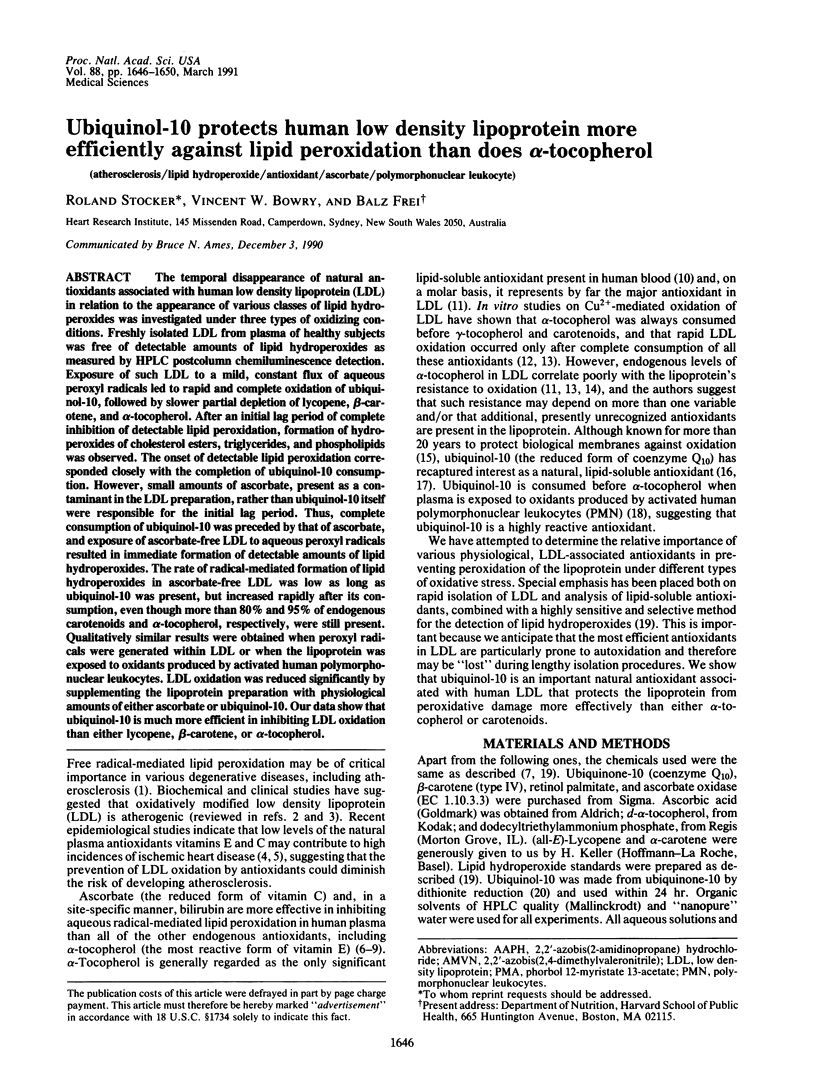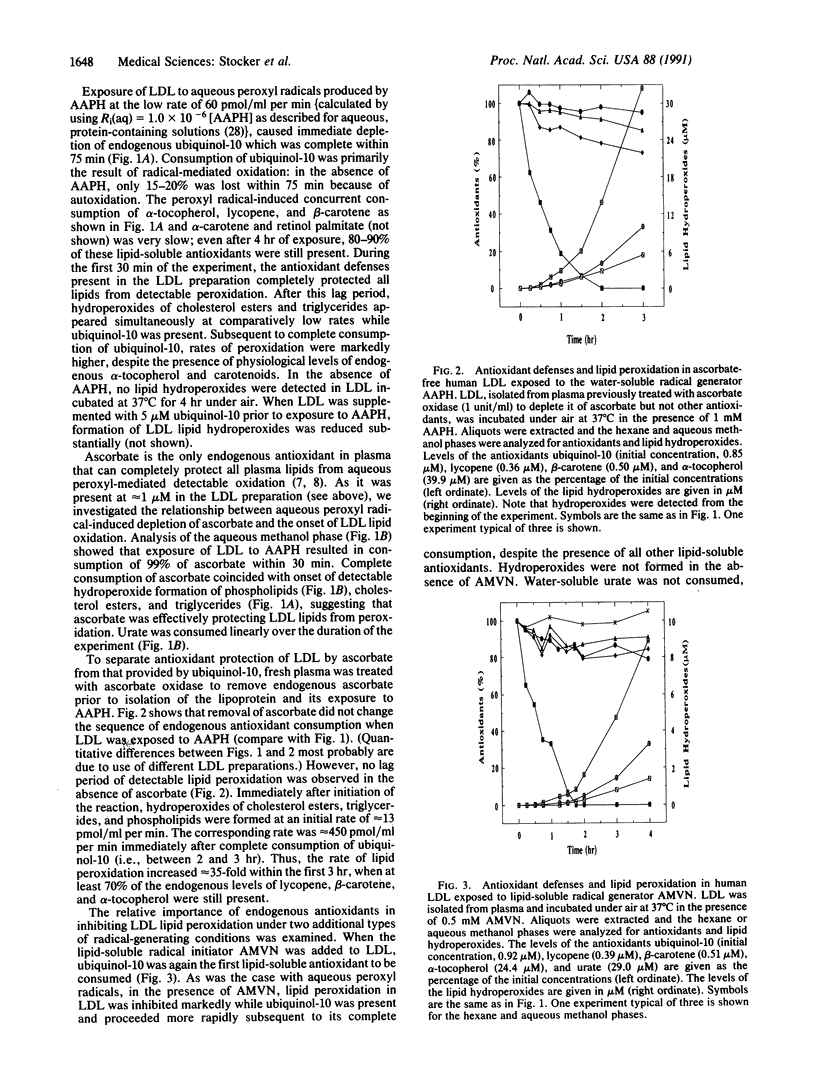Abstract
The temporal disappearance of natural antioxidants associated with human low density lipoprotein (LDL) in relation to the appearance of various classes of lipid hydroperoxides was investigated under three types of oxidizing conditions. Freshly isolated LDL from plasma of healthy subjects was free of detectable amounts of lipid hydroperoxides as measured by HPLC postcolumn chemiluminescence detection. Exposure of such LDL to a mild, constant flux of aqueous peroxyl radicals led to rapid and complete oxidation of ubiquinol-10, followed by slower partial depletion of lycopene, beta-carotene, and alpha-tocopherol. After an initial lag period of complete inhibition of detectable lipid peroxidation, formation of hydroperoxides of cholesterol esters, triglycerides, and phospholipids was observed. The onset of detectable lipid peroxidation corresponded closely with the completion of ubiquinol-10 consumption. However, small amounts of ascorbate, present as a contaminant in the LDL preparation, rather than ubiquinol-10 itself were responsible for the initial lag period. Thus, complete consumption of ubiquinol-10 was preceded by that of ascorbate, and exposure of ascorbate-free LDL to aqueous peroxyl radicals resulted in immediate formation of detectable amounts of lipid hydroperoxides. The rate of radical-mediated formation of lipid hydroperoxides in ascorbate-free LDL was low as long as ubiquinol-10 was present, but increased rapidly after its consumption, even though more than 80% and 95% of endogenous carotenoids and alpha-tocopherol, respectively, were still present. Qualitatively similar results were obtained when peroxyl radicals were generated within LDL or when the lipoprotein was exposed to oxidants produced by activated human polymorphonuclear leukocytes. LDL oxidation was reduced significantly by supplementing the lipoprotein preparation with physiological amounts of either ascorbate or ubiquinol-10. Our data show that ubiquinol-10 is much more efficient in inhibiting LDL oxidation than either lycopene, beta-carotene, or alpha-tocopherol.
Full text
PDF




Selected References
These references are in PubMed. This may not be the complete list of references from this article.
- Babiy A. V., Gebicki J. M., Sullivan D. R. Vitamin E content and low density lipoprotein oxidizability induced by free radicals. Atherosclerosis. 1990 Apr;81(3):175–182. doi: 10.1016/0021-9150(90)90064-p. [DOI] [PubMed] [Google Scholar]
- Beyer R. E. The participation of coenzyme Q in free radical production and antioxidation. Free Radic Biol Med. 1990;8(6):545–565. doi: 10.1016/0891-5849(90)90154-b. [DOI] [PubMed] [Google Scholar]
- Burton G. W., Joyce A., Ingold K. U. Is vitamin E the only lipid-soluble, chain-breaking antioxidant in human blood plasma and erythrocyte membranes? Arch Biochem Biophys. 1983 Feb 15;221(1):281–290. doi: 10.1016/0003-9861(83)90145-5. [DOI] [PubMed] [Google Scholar]
- Cathcart M. K., Morel D. W., Chisolm G. M., 3rd Monocytes and neutrophils oxidize low density lipoprotein making it cytotoxic. J Leukoc Biol. 1985 Aug;38(2):341–350. doi: 10.1002/jlb.38.2.341. [DOI] [PubMed] [Google Scholar]
- Chung B. H., Segrest J. P., Ray M. J., Brunzell J. D., Hokanson J. E., Krauss R. M., Beaudrie K., Cone J. T. Single vertical spin density gradient ultracentrifugation. Methods Enzymol. 1986;128:181–209. doi: 10.1016/0076-6879(86)28068-4. [DOI] [PubMed] [Google Scholar]
- Cornell B. A., Keniry M. A., Post A., Robertson R. N., Weir L. E., Westerman P. W. Location and activity of ubiquinone 10 and ubiquinone analogues in model and biological membranes. Biochemistry. 1987 Dec 1;26(24):7702–7707. doi: 10.1021/bi00398a025. [DOI] [PubMed] [Google Scholar]
- Cross C. E., Forte T., Stocker R., Louie S., Yamamoto Y., Ames B. N., Frei B. Oxidative stress and abnormal cholesterol metabolism in patients with adult respiratory distress syndrome. J Lab Clin Med. 1990 Apr;115(4):396–404. [PubMed] [Google Scholar]
- Cushing S. D., Berliner J. A., Valente A. J., Territo M. C., Navab M., Parhami F., Gerrity R., Schwartz C. J., Fogelman A. M. Minimally modified low density lipoprotein induces monocyte chemotactic protein 1 in human endothelial cells and smooth muscle cells. Proc Natl Acad Sci U S A. 1990 Jul;87(13):5134–5138. doi: 10.1073/pnas.87.13.5134. [DOI] [PMC free article] [PubMed] [Google Scholar]
- Esterbauer H., Jürgens G., Quehenberger O., Koller E. Autoxidation of human low density lipoprotein: loss of polyunsaturated fatty acids and vitamin E and generation of aldehydes. J Lipid Res. 1987 May;28(5):495–509. [PubMed] [Google Scholar]
- Folkers K., Langsjoen P., Willis R., Richardson P., Xia L. J., Ye C. Q., Tamagawa H. Lovastatin decreases coenzyme Q levels in humans. Proc Natl Acad Sci U S A. 1990 Nov;87(22):8931–8934. doi: 10.1073/pnas.87.22.8931. [DOI] [PMC free article] [PubMed] [Google Scholar]
- Frei B., England L., Ames B. N. Ascorbate is an outstanding antioxidant in human blood plasma. Proc Natl Acad Sci U S A. 1989 Aug;86(16):6377–6381. doi: 10.1073/pnas.86.16.6377. [DOI] [PMC free article] [PubMed] [Google Scholar]
- Frei B., Kim M. C., Ames B. N. Ubiquinol-10 is an effective lipid-soluble antioxidant at physiological concentrations. Proc Natl Acad Sci U S A. 1990 Jun;87(12):4879–4883. doi: 10.1073/pnas.87.12.4879. [DOI] [PMC free article] [PubMed] [Google Scholar]
- Frei B., Stocker R., Ames B. N. Antioxidant defenses and lipid peroxidation in human blood plasma. Proc Natl Acad Sci U S A. 1988 Dec;85(24):9748–9752. doi: 10.1073/pnas.85.24.9748. [DOI] [PMC free article] [PubMed] [Google Scholar]
- Frei B., Yamamoto Y., Niclas D., Ames B. N. Evaluation of an isoluminol chemiluminescence assay for the detection of hydroperoxides in human blood plasma. Anal Biochem. 1988 Nov 15;175(1):120–130. doi: 10.1016/0003-2697(88)90369-7. [DOI] [PubMed] [Google Scholar]
- Gey K. F., Puska P. Plasma vitamins E and A inversely correlated to mortality from ischemic heart disease in cross-cultural epidemiology. Ann N Y Acad Sci. 1989;570:268–282. doi: 10.1111/j.1749-6632.1989.tb14926.x. [DOI] [PubMed] [Google Scholar]
- Grootveld M., Halliwell B. Measurement of allantoin and uric acid in human body fluids. A potential index of free-radical reactions in vivo? Biochem J. 1987 May 1;243(3):803–808. doi: 10.1042/bj2430803. [DOI] [PMC free article] [PubMed] [Google Scholar]
- Hara I., Okazaki M. High-performance liquid chromatography of serum lipoproteins. Methods Enzymol. 1986;129:57–78. doi: 10.1016/0076-6879(86)29062-x. [DOI] [PubMed] [Google Scholar]
- Jessup W., Rankin S. M., De Whalley C. V., Hoult J. R., Scott J., Leake D. S. Alpha-tocopherol consumption during low-density-lipoprotein oxidation. Biochem J. 1990 Jan 15;265(2):399–405. doi: 10.1042/bj2650399. [DOI] [PMC free article] [PubMed] [Google Scholar]
- Kagan V. E., Serbinova E. A., Koynova G. M., Kitanova S. A., Tyurin V. A., Stoytchev T. S., Quinn P. J., Packer L. Antioxidant action of ubiquinol homologues with different isoprenoid chain length in biomembranes. Free Radic Biol Med. 1990;9(2):117–126. doi: 10.1016/0891-5849(90)90114-x. [DOI] [PubMed] [Google Scholar]
- Lang J. K., Gohil K., Packer L. Simultaneous determination of tocopherols, ubiquinols, and ubiquinones in blood, plasma, tissue homogenates, and subcellular fractions. Anal Biochem. 1986 Aug 15;157(1):106–116. doi: 10.1016/0003-2697(86)90203-4. [DOI] [PubMed] [Google Scholar]
- Littarru G. P., Ho L., Folkers K. Deficiency of coenzyme Q 10 in human heart disease. II. Int J Vitam Nutr Res. 1972;42(3):413–434. [PubMed] [Google Scholar]
- Mellors A., Tappel A. L. The inhibition of mitochondrial peroxidation by ubiquinone and ubiquinol. J Biol Chem. 1966 Oct 10;241(19):4353–4356. [PubMed] [Google Scholar]
- Rajavashisth T. B., Andalibi A., Territo M. C., Berliner J. A., Navab M., Fogelman A. M., Lusis A. J. Induction of endothelial cell expression of granulocyte and macrophage colony-stimulating factors by modified low-density lipoproteins. Nature. 1990 Mar 15;344(6263):254–257. doi: 10.1038/344254a0. [DOI] [PubMed] [Google Scholar]
- Riemersma R. A., Wood D. A., Macintyre C. C., Elton R., Gey K. F., Oliver M. F. Low plasma vitamins E and C. Increased risk of angina in Scottish men. Ann N Y Acad Sci. 1989;570:291–295. doi: 10.1111/j.1749-6632.1989.tb14928.x. [DOI] [PubMed] [Google Scholar]
- Sato K., Niki E., Shimasaki H. Free radical-mediated chain oxidation of low density lipoprotein and its synergistic inhibition by vitamin E and vitamin C. Arch Biochem Biophys. 1990 Jun;279(2):402–405. doi: 10.1016/0003-9861(90)90508-v. [DOI] [PubMed] [Google Scholar]
- Steinberg D., Parthasarathy S., Carew T. E., Khoo J. C., Witztum J. L. Beyond cholesterol. Modifications of low-density lipoprotein that increase its atherogenicity. N Engl J Med. 1989 Apr 6;320(14):915–924. doi: 10.1056/NEJM198904063201407. [DOI] [PubMed] [Google Scholar]
- Steinbrecher U. P., Zhang H. F., Lougheed M. Role of oxidatively modified LDL in atherosclerosis. Free Radic Biol Med. 1990;9(2):155–168. doi: 10.1016/0891-5849(90)90119-4. [DOI] [PubMed] [Google Scholar]
- Stocker R., Glazer A. N., Ames B. N. Antioxidant activity of albumin-bound bilirubin. Proc Natl Acad Sci U S A. 1987 Aug;84(16):5918–5922. doi: 10.1073/pnas.84.16.5918. [DOI] [PMC free article] [PubMed] [Google Scholar]
- Stocker R., Winterhalter K. H., Richter C. Increased fluorescence polarization of 1,6-diphenyl-1,3,5-hexatriene in the phorbol myristate acetate-stimulated plasma membrane of human neutrophils. FEBS Lett. 1982 Aug 2;144(2):199–203. doi: 10.1016/0014-5793(82)80637-6. [DOI] [PubMed] [Google Scholar]
- Wayner D. D., Burton G. W., Ingold K. U., Barclay L. R., Locke S. J. The relative contributions of vitamin E, urate, ascorbate and proteins to the total peroxyl radical-trapping antioxidant activity of human blood plasma. Biochim Biophys Acta. 1987 Jun 22;924(3):408–419. doi: 10.1016/0304-4165(87)90155-3. [DOI] [PubMed] [Google Scholar]
- Yamamoto Y., Frei B., Ames B. N. Assay of lipid hydroperoxides using high-performance liquid chromatography with isoluminal chemiluminescence detection. Methods Enzymol. 1990;186:371–380. doi: 10.1016/0076-6879(90)86130-n. [DOI] [PubMed] [Google Scholar]


